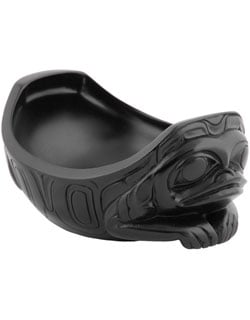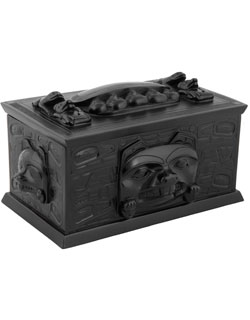Scrimshaw
Scrimshaw work among the coastal Indians developed from the scrimshaw the
sailors made on the ships trading for furs. These sailors often occupied their
leisure time carving curios from ivory, bone or wood, as gifts for those at
home or to trade for curios from foreign parts as they traveled. The early
Indian scrimshaw was largely imitative of the sailors' work, but soon began
to show the native designs already well developed in totem poles, masks and
house and box carvings. Carvings were done in ivory, bone, and wood, and bracelets
were made in copper, silver and gold, the copper from sheet copper traded
from the ships, the silver and gold from coins beaten flat. The most valuable,
and sought after, of the scrimshaw and carvings was carved by the Haida from
argillite, a soft slate found only in a deposit near Skidegate in the Queen
Charlotte Islands, British Columbia. Development of the totem poles and the
scrimshaw work was a phenomenon of the nineteenth century, dependant upon the
tools obtained from trade and a market for curios among the traders and visitors
from outside. The finest period for the art was the last half of the century,
1850 - 1900. Towards the end of the century as government, co-operating with
churches, worked to undermine the self-respect of tribes already cut down
by disease, production of scrimshaw almost ceased. Some wood carvings and
engraved silver bracelets continued to be offered by the Tlingits in Alaska,
and silver bracelets die stamped in Seattle to Tlingit designs by Bill
Wilson and Amos
Wallace were sold up the coast to both Indians
and tourists, but little was available from Canada.
A revival started after the 2nd World War, and was given a major impetus in Canada when the government ruled that nothing could be sold as Indian (or Eskimo) art unless made by Indians (or Eskimos). Today, Indian art work is available in both classic and modern styles developed from the classic forms, much of it of outstanding quality. Wood carvings, as masks, rattles, bowls, totem poles, both full size and miniature, and bent-wood boxes are all available on the general market. Bracelets, and nowadays earrings, pendants and pins are available. Unique bracelets are hand engraved by the recognized Indian artists, but primarily as work commissioned by tribal members. Such work largely stays within the tribe. Bracelets die stamped in Seattle have been a trade item since the early 1900's, when Joseph Mayer first put Tlingit designed bracelets onto dies. Bracelets and other silverwork to designs by current Indian artists, such as Danny Dennis, Everett Goenett, Robert Hewson and Odin Lonning, are now offered in addition to the older trade bracelets. Horn spoons are seldom seen, but reproductions or newer designs are occasionally offered in silver or pewter. Argillite carvings, in many ways the finest medium for totemic art, are available in small numbers and small size. Some years ago the deposit was blasted to make it easier to extract the slate, but the blasting shattered the rock, leaving only small pieces, suitable for pins and pendants but too small for the totem poles, plates, and boxes that were such magnificent examples of the Haida carvers' art. The older work has largely passed to museums, although some comes onto the market at prices that make it unsuitable for casual display. Quality reproductions of the older work are available in a range of styles that can be more casually displayed so that the art can be enjoyed on an every day basis.
For more information ...
Please follow the links below to learn more about the Pacific Northwest Coast
Indian jewelry and reproductions we offer and other related items and information.
![]() Reproductions
of Argillite Carvings
Reproductions
of Argillite Carvings
![]() Clam
Shell Box, Detailed Views
Clam
Shell Box, Detailed Views
![]() Totem
Poles
Totem
Poles
![]() NW
Indian Jewelry
NW
Indian Jewelry
![]() Trade
Bracelets
Trade
Bracelets
![]() Pacific
Northwest Coast Indian Art & Lore
Pacific
Northwest Coast Indian Art & Lore
![]() NW
Coast Indian Tribes and Their Art
NW
Coast Indian Tribes and Their Art
![]() Jewelry
FAQs
Jewelry
FAQs
|

